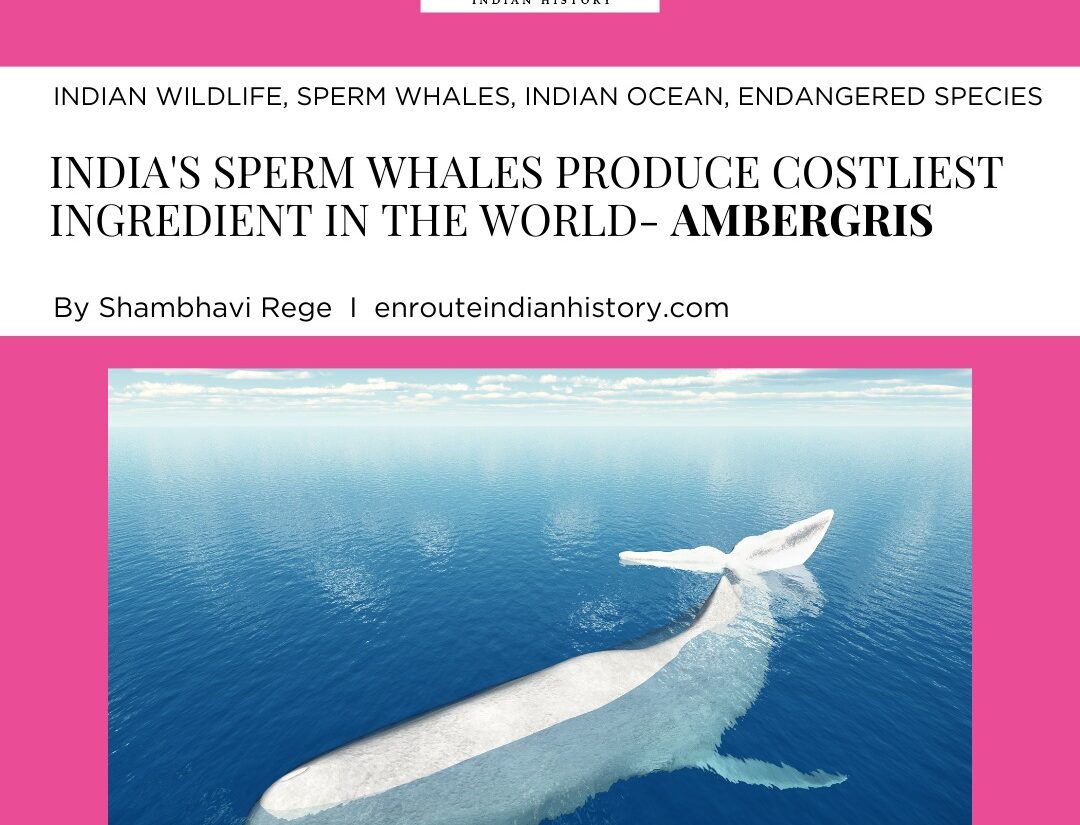India’s sperm whales produce costliest ingredient in the world- ambergris
- EIH User
- March 1, 2024

In some regions in India, whales are called Dev Masa, meaning the ‘God Fish’. They are called so due to their gigantic size and majestic aura that surrounds them. In the coastal parts of Maharashtra and Goa, whales are both feared and respected. Blue whales, sperm whales, killer whales or orcas are some of the types that are sighted on Indian seashores. The Indian Ocean is home to the sperm whales. They are distinguished by their unique appearance and the treasure that is present in them. According to the Wildlife (Protection) Act, of 1972, sperm whales are endangered species. The sale, transfer and trade of ambergris is illegal in India. They are under threat due to ambergris, a substance found in the intestines of sperm whales. It is in great demand for its use in perfumery, medicines etc.

Sperm Whales are one of the largest mammals and the largest toothed predators.
(Image credit – Awesome Ocean
Link – http://awesomeocean.com/whales/surprising-discovery-in-the-indian-ocean/)
The sperm whales are the largest toothed predator on earth. They have the largest brains. Found in all the oceans of the world they are dark brown to grey in appearance. They can dive at the deepest points of the ocean. This unique member of marine life has an equally unique appearance characterised by an enormous square head and a narrower jaw. The blunt-shaped head has a s-shaped blowhole that produces a distinct blow. Spermaceti, originally mistaken as a whale’s sperm, is found in its head. The whales derive their name from this spermaceti, also known as sperm oil. The male sperm whales migrate often while the females and calves live in clustered pods in the warm tropical zones of oceans. Their diet typically includes deep-water squid, fish, and octopus.
Sperm whales in India
Sperm whales have three species. Indian waters are home to all three species. They are found in various parts of the Indian Ocean. The Indian Ocean houses the world’s only resident pod. They are found mostly in the Arabian Sea, near Gujarat and the Bay of Bengal near Orissa. They are also sighted near the Andaman and Nicobar Islands. Their sightings at the Andaman Islands are quite frequent. December to April is considered a favourable time for whale watching. Often washed up on the Indian shores, the sperm whale is either dead, hurt or stranded. They are endangered species in India. There are several causes for the danger to sperm whales, and one important reason is ambergris, a natural substance found in the sperm whale.

Ambergris is a wax-like substance originating from the intestines of a sperm whale.
(Image credit- https://www.ambergris.co.nz/about-ambergris)
Ambergris and its uses
Extracts taken from flowers and animal products have been often used by humans to fragrant their bodies. Ambergris is one such natural substance that has been used in perfume making. Ambergris is a soft and fatty substance that resembles beeswax. This concretion is originally in the intestinal tract of sperm whales. It is cast out in the water when a whale vomits it. This substance cast out in the ocean gets under long exposure to air, sun and seawater. This alters its physical properties. Its black colours turn into lighter grey and the extremely smelly substance is turned into the one that is highly expensive in markets.
Ambergris is used in various ways in India and the world. It was traditionally used in perfumery due to its unique earthy smell. Ambergris is highly valued due to its fixed properties. It slows down the evaporation of other fragrance components and prolongs the scent of perfumes. Its origins were unknown for a long time but recent studies have shown that when whales eat its favourite diet of squid and cuttlefish, its beaks are too sharp to be digested by the whale’s body. The secretion is released to make a wrapping around the beaks and claws so that internal organs are not at risk of getting hurt. This substance then gets expelled from the whale’s body and floats towards the seashore.
Though the use of ambergris in perfume making is documented in the works of many foreign travellers who visited India during the mediaeval period. Marco Polo, Bernier, and Ibn Battuta all mention the use of ambergris. In Ain I Akbari by Abul Fazl there is a mention of preparation of ambergris. The unique aroma of ambergris has left its trail in the pages of history. The use of ambergris was noted in medicines as well. It was used to make medicines, potions and spices. There are records of Europeans using ambergris as a medication to treat headaches, colds etc. It finds mention in Ayurvedic texts as well. In the modern day, it is used for treatment of heartburn, cough, stomach ache etc. though the ambergris that is used in today’s time is less authentic. Laws that protect the sperm whales have made it difficult for the possession and sale of ambergris. A small amount of real ambergris is usually mixed with synthetic ambergris.

A carved tooth of a sperm whale.
(Image credit- National Museum of American History
Link – https://www.ambergris.co.nz/about-ambergris)
Whaling and illegal trade
Ambergris has been called the floating gold or the treasure of the sea due to its value and uses. However, it poses a real threat to the marine life that carries it within themselves. Sperm whales have been hunted and killed to obtain the substance. The substance that is formed in the intestine of the whales to protect the whale’s organs from the sharp squid beaks that they consume is often the reason behind their poaching. The whale vomit that floated to the seashores was quickly noticed to be beneficial and human greed took over. Ambergris is the main reason behind their widespread hunting but not the only reason. Sperm whales are also hunted for their teeth. These teeth are used as ornaments, in jewellery and as pieces of decor. The spermaceti was used in the process of making candles, oil lamps etc. All these reasons led to a brutal hunt of sperm whales along the shores of India. In the mid-19th and 20th centuries, they were hunted massively which brought danger to the entire population and their habitat.
Recent studies have shown the patterns in which sperm whales sleep.

(Image credit – Photograph by Staphane Granzotto, National Geographic
https://www.nationalgeographic.com/photography/article/sperm-whales-nap-sleeping-photography-spd)
Endangered species
Sperm whales face numerous threats to their existence. There are reports of sperm whales getting injured due to getting attacked by the orcas or killer whales and facing the biggest threat which is commercial whalers. Climate change has led to a loss of their usual habitats. Changes in ocean temperature, currents and other external factors lead to changes in squid distribution which is the main source of food of sperm whales. It has adverse effects on their populations. It is difficult to estimate the number of sperm whales that are present in the Indian waters as they are migratory species.
Whales are magnificent creatures in marine life. They play a vital role in the ocean’s ecosystem. Over the years they were hunted in massive numbers which led to a significant decline in their population. They also get stranded on the shores and though in many instances the locals and fishermen come forward to help these whales, they often perish on the shores. In Spite of the laws to protect the whales, desirable results cannot be seen. The waters of Andaman are a quite frequented spot of the sperm whales and these waters, which are a part of North Indian Ocean Whale sanctuary set up by International whaling commission needs more scientific documentation and a study of conducive habitat for their growth. Presently India does not have a dedicated marine sanctuary for the rehabilitation and protection of sperm whales though it has supported the concept of an Ocean sanctuary for whales and the stoppage of whaling.
References
Karl.H.Dannenfeldt. “Ambergris: The search for its origin.” Isis (1982): 382-397.
Machida, Saburo. “Distribution of Sperm Whale catches in the southern Indian Ocean.” Whales Research Institute (1975): 141-157.
Merril.E.Gosho, Dal.W.Rice and Jeffrey .M.Breiwick. “The Sperm Whale, Physter macrocephalus .” Marine Fisheries Review (1984): 54-64.
P.K.Gode. “History of Ambergris in India between about A.D.700 and 1900.” Chymia (1949): 51-56.
T.M.Srinivasan. “Ambergris in perfumery in the past and present Indian Context and the western world .” Indian Journal of History of Science (2015): 306-323.
U.G.Naik, J.L.Rathod. S.B.Haragi. “Sperm Whale Physeter macrocephalus stranded at Devbhagh beach, Karwar, western coast of India.” Journal of threatened Taxa (2010): 1338- 1341.
Whitehead, Hal. Sperm Whales : A Social evolution in the ocean. Chicago: University of Chicago Press, 2003.
- May 15, 2024
- 6 Min Read























